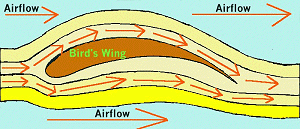Photos by Brenton Savikko
Birds
Now that we covered the basics, lets explore the physics behind some of the sights you will be seeing on your outing, starting with birds.
Photos by Brenton Savikko |
The bald eagle is not an uncommon sight when boating in Southeast Alaska. It is a massive bird that flies with the greatest of ease. Lets take a look at the casually oversimplified physics behind the flight of a bird. Basically, birds wings are not flat but are shaped like an aerofoil. "Air passes over or under the wing as the bird moves forward, or as the wind blows. The air that moves over the top of the wing has further to travel to get across the wing, thus it speeds up. This causes the pressure to drop because the same amount of air is exerting its pressure over a greater area. Therefore, any given point experiences less pressure. This effectively sucks the wing up. Meanwhile the air going below the wing experiences the opposite effect. It slows down, generates more pressure and effectively pushes the wing up." Hence a bird with air moving over its wings is pulled up from above and pushed up from below.
 ( http://www.earthlife.net/birds/flight.html [diagram and quote])
( http://www.earthlife.net/birds/flight.html [diagram and quote])
This pressure difference is what causes lift and makes an eagle, or this arctic turn below, able to soar high above the water.
(Photo by Brenton Savikko)